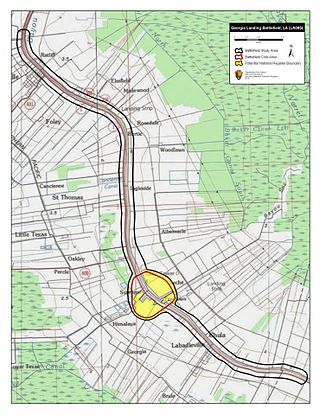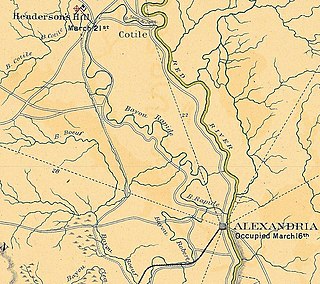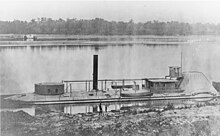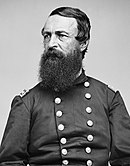
The third USS Lexington was a timberclad gunboat in the United States Navy during the American Civil War.

The first USS Lafayette was a side wheel steamer, converted to an ironclad ram, in the United States Navy during the American Civil War.

The Red River campaign, also known as the Red River expedition, was a major Union offensive campaign in the Trans-Mississippi theater of the American Civil War, the campaign taking place from March 10 to May 22, 1864. It was launched through the densely forested gulf coastal plain region between the Red River Valley and central Arkansas towards the end of the war. The offensive was intended to stop Confederate use of the Louisiana port of Shreveport, open an outlet for the sugar and cotton of northern Louisiana, and to split the Confederate lines, allowing the Union to encircle and destroy the Confederate military forces in Louisiana and southern Arkansas. It marked the last major offensive attempted by the Union in the Trans-Mississippi Theater.

The Battle of Port Gibson was fought between a Union Army commanded by Major General Ulysses S. Grant and a reinforced Confederate States Army division led by Major General John S. Bowen. Though the outnumbered Confederate soldiers fought stubbornly, they were steadily pressed back during the day by Major General John A. McClernand's troops. Bowen eventually conceded the field by withdrawing north toward Vicksburg, Mississippi. The battle occurred near Port Gibson, Mississippi, during the Vicksburg Campaign of the American Civil War.

USS Marmora was a sternwheel steamer that served in the Union Navy from 1862 to 1865, during the American Civil War. Built in 1862 at Monongahela, Pennsylvania, as a civilian vessel, she was purchased for military service on September 17 and converted into a tinclad warship. Commissioned on October 21, the vessel served on the Yazoo River beginning the next month. She encountered Confederate naval mines on the Yazoo on December 11, and was present the next day when the ironclad USS Cairo was sunk by two mines. After further service on the Yazoo during the Battle of Chickasaw Bayou in late December, Marmora was assigned in January 1863 to a fleet that was preparing to operate against Confederate Fort Hindman, but was not present when the fort surrendered on January 11.

The Battle of Grand Gulf was fought on April 29, 1863, during the American Civil War. Union Army forces commanded by Major General Ulysses S. Grant had failed several times to bypass or capture the Confederate-held city of Vicksburg, Mississippi, during the Vicksburg campaign. Grant decided to move his army south of Vicksburg, cross the Mississippi River, and then advance on the city. A Confederate Army division under Brigadier General John S. Bowen prepared defenses—Forts Wade and Cobun—at Grand Gulf, Mississippi, south of Vicksburg. To clear the way for a Union crossing, seven Union Navy ironclad warships from the Mississippi Squadron commanded by Admiral David Dixon Porter bombarded the Confederate defenses at Grand Gulf on April 29. Union fire silenced Fort Wade and killed its commander, but the overall Confederate position held. Grant decided to cross the river elsewhere.

The Battle of Monett's Ferry or Monett's Bluff saw a Confederate States Army force led by Brigadier General Hamilton P. Bee attempt to block a numerically superior Union Army column that was commanded by Brigadier General William H. Emory during the Red River Campaign of the American Civil War. Confederate commander Major General Richard Taylor set a trap for the retreating army of Major General Nathaniel P. Banks near the junction of the Cane River with the Red River. Taylor assigned Bee's troops to plug up the only outlet from the trap while Taylor's other forces closed in from the rear and sides.
The Battle of Yellow Bayou, also known as the Battle of Norwood's Plantation, saw Union Army forces led by Brigadier General Joseph A. Mower clash with Confederate States Army troops commanded by Brigadier General John A. Wharton in Avoyelles Parish, Louisiana during the American Civil War. This was the final action of the Red River campaign in which a Union army under Major General Nathaniel P. Banks was repulsed by Confederate forces led by Major General Richard Taylor. The failed Union campaign almost ended in disaster when an accompanying Union fleet led by Rear Admiral David Dixon Porter was trapped at Alexandria, Louisiana, by low water in the Red River. An engineering feat saved the fleet, allowing Banks' army to complete its withdrawal.

The Battle of Georgia Landing or Battle of Labadieville was fought between a Union Army force led by Brigadier General Godfrey Weitzel and a Confederate States Army force commanded by Brigadier General Alfred Mouton near Labadieville, Assumption Parish, Louisiana, during the American Civil War. After a sharp clash, the Union troops compelled Mouton's outnumbered force to retreat.

The 13th Maine Infantry Regiment was an infantry regiment that served in the Union Army during the American Civil War. The regiment spent 1862–1864 in the Department of the Gulf and finished the war with the Army of the Shenandoah. During its service, it survived a hurricane off the Carolinas en route the Gulf of Mexico, manned the forts guarding the Mississippi Delta, invaded Texas at the Rio Grande and along the coast, fought in Banks' ill-fated Red River Campaign in Louisiana, manned Washington, D.C., defenses, and provided rear-area security for the Shenandoah Valley campaign in 1864 south of Harpers Ferry.

The 12th Texas Cavalry Regiment was a unit of mounted volunteers recruited in Texas that fought in the Confederate States Army during the American Civil War. The regiment was enrolled in state service in September 1861 and in Confederate service the following month. The regiment fought at Whitney's Lane, Cotton Plant, and L'Anguille Ferry in 1862, Goodrich's Landing in 1863, and Blair's Landing and Yellow Bayou in 1864. The unit also participated in numerous skirmishes and scouts. It disbanded in May 1865.

The 11th Texas Infantry Regiment was a unit of volunteers recruited in Texas that fought in the Confederate States Army during the American Civil War. The regiment organized in the winter of 1861–1862 and always served west of the Mississippi River in the Trans-Mississippi Department. The unit was assigned to the 2nd Brigade of the Texas infantry division known as Walker's Greyhounds. The regiment fought at Milliken's Bend and Bayou Bourbeux in 1863 and Mansfield, Pleasant Hill, and Jenkins' Ferry in 1864. The regiment disbanded in mid-May 1865, but its formal surrender date was 26 May 1865.

The Battle of Henderson's Hill, also known as the Bayou Rapides, saw a reinforced Union Army division led by Brigadier General Joseph A. Mower opposed by a regiment of Confederate Army cavalry and attached artillery under Colonel William G. Vincent. That evening, during a rainstorm, Mower sent one infantry brigade on a circuitous march to gain the rear of Vincent's command. The brigade's subsequent attack surprised and captured most of the Confederates. Mower could not exploit his minor victory because the arrival of additional Federal army and naval units was delayed. This clash occurred during the Red River campaign of the American Civil War which saw Major General Nathaniel P. Banks' Union army try to seize Shreveport, Louisiana, from its Confederate defenders led by Lieutenant General Richard Taylor.

1st Texas Field Battery or Edgar's Company was an artillery battery from Texas that served in the Confederate States Army during the American Civil War. The artillery company formed in November 1860, but was not formally taken into Confederate service until April 1861. The unit participated in the disarming and surrender of United States soldiers and property in Texas in early 1861. The battery marched to Arkansas where in 1862 it joined the infantry division known as Walker's Greyhounds. The battery fought at Milliken's Bend and Richmond (La.), shelled a Federal river transport, and campaigned in south Louisiana in late 1863. The 1st Texas Battery was captured at Henderson's Hill in March 1864. The soldiers were later exchanged, and the unit disbanded in 1865 at the end of the conflict.

The 28th Texas Cavalry Regiment was a unit of mounted volunteers recruited in east Texas that fought in the Confederate States Army during the American Civil War. In May 1862, the regiment entered Confederate service and served the entire war west of the Mississippi River in the region known as the Trans-Mississippi Department. The unit was soon dismounted before being assigned to the 2nd Brigade of the all-Texas infantry division known as Walker's Greyhounds. In 1863, the regiment played a secondary role at Milliken's Bend. The regiment fought in three major battles during April 1864, at Mansfield, Pleasant Hill, and Jenkins' Ferry. The Trans-Mississippi Department surrendered on 26 May 1865, but the survivors dispersed to their homes before that date.

The 2nd Louisiana Cavalry Regiment was a unit of mounted volunteers recruited in Louisiana that fought in the Confederate States Army during the American Civil War. Breazeale's Cavalry Battalion was formed in July 1862 and was augmented by five additional companies in September 1862 to form a regiment. It served for the entire war west of the Mississippi River in the Trans-Mississippi Department. The regiment fought at Georgia Landing, Fort Bisland, Irish Bend, and Brashear City in 1863 and Henderson's Hill and Mansfield in 1864. Afterward, the regiment fought in minor skirmishes before the Trans-Mississippi's final surrender on 26 May 1865.

The 1st Louisiana Field Battery was an artillery unit recruited from volunteers in Louisiana that fought in the Confederate States Army during the American Civil War. The battery mustered into Confederate service in October 1861. The unit traveled to Fort Jackson in early 1862 and took part in the defense of Forts Jackson and St. Philip. The soldiers became prisoners when the forts surrendered and the battery reformed at Franklin after their prisoner exchange. The battery fought at Fort Bisland and Irish Bend in 1863. Later in the year the battery engaged Union shipping on the rivers in several actions. In 1864 the battery briefly fought at Mansfield before its commander was killed while engaging Union gunboats in late April. The unit also fought at Mansura and Yellow Bayou. The battery was in Texas when the Trans-Mississippi Department surrendered in May 1865.

The Actions near Alexandria saw a Confederate States Army force commanded by Major General Richard Taylor surround a greatly superior Union Army led by Major General Nathaniel P. Banks and a United States Navy flotilla commanded by Rear Admiral David Dixon Porter at Alexandria, Louisiana. Porter's gunboats were trapped above the double falls in the Red River by low water. Banks' army was compelled to halt its retreat to keep Porter's vessels from being scuttled or from falling into Confederate hands.

The Action of April 26–27, 1864 saw a Confederate States Army force led by Lieutenant Colonel John H. Caudle and Captain Florian Cornay ambush several Union Navy warships and auxiliary vessels commanded by Rear Admiral David Dixon Porter as they made their way downstream on the Red River of the South. Eleven days earlier, a Confederate naval mine sank a Union ironclad warship. The vessel was refloated and escorted downstream by Porter with five Union vessels, but on April 26 the ironclad had to be scuttled.

Oliver Paul Gooding was an officer in the Union Army during the American Civil War and was brevetted Major General for his war service. He graduated from the United States Military Academy in 1858 and served in the Utah expedition. After the Civil War broke out he was named colonel of an infantry regiment and accompanied the New Orleans expedition in 1862. He led an infantry brigade at Fort Bisland and Port Hudson in 1863. He led a cavalry brigade in the Red River campaign in 1864. After the war he practiced law and wrote two religious books.

























